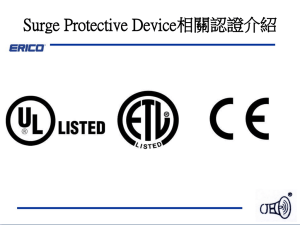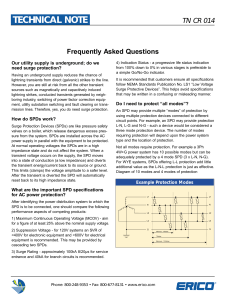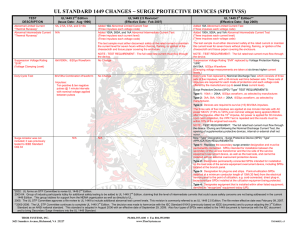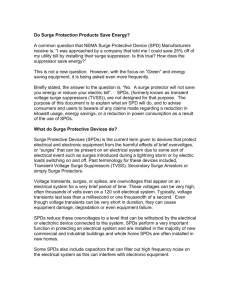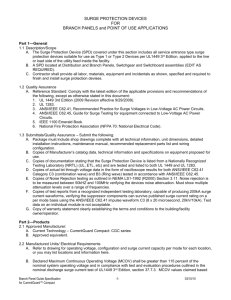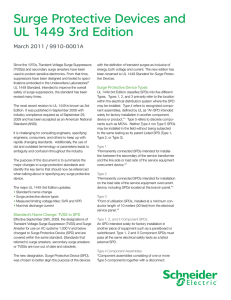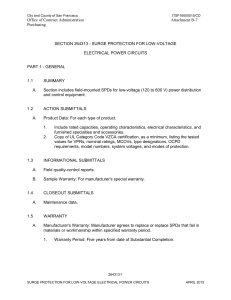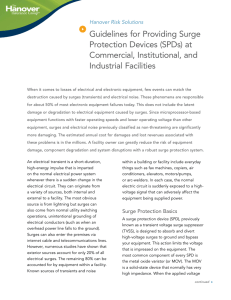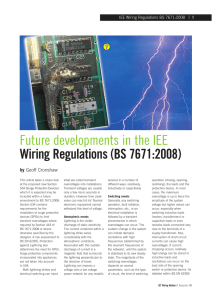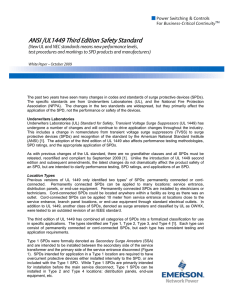UL1449 3rd Edition - Hubbell Wiring Device
advertisement
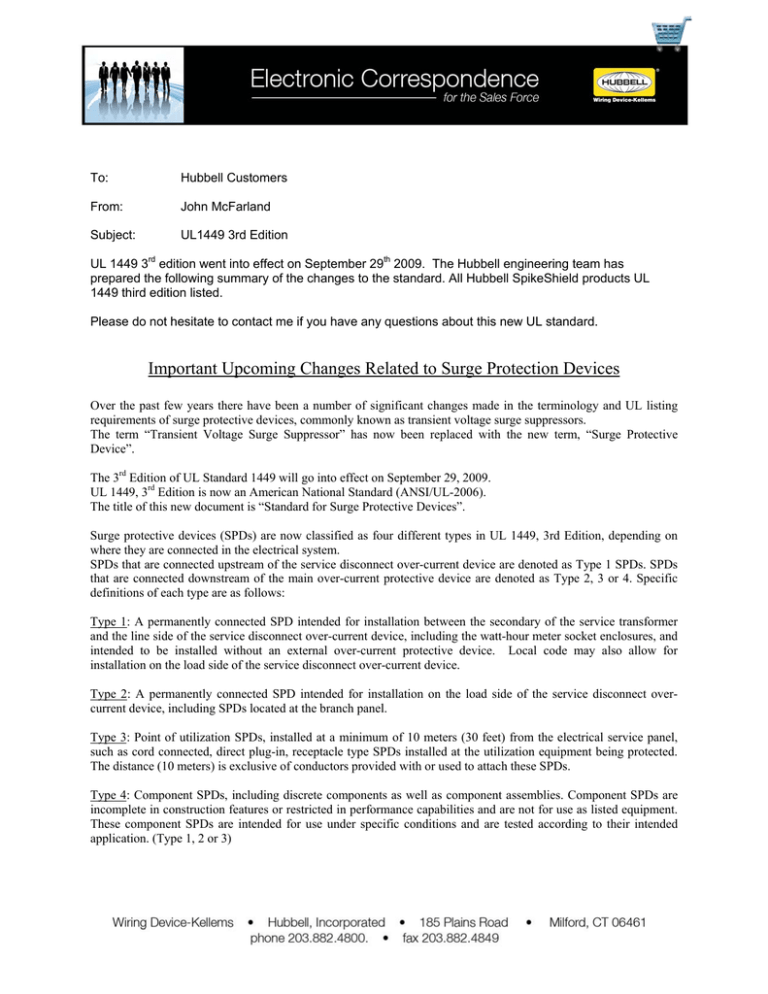
To: Hubbell Customers From: John McFarland Subject: UL1449 3rd Edition UL 1449 3rd edition went into effect on September 29th 2009. The Hubbell engineering team has prepared the following summary of the changes to the standard. All Hubbell SpikeShield products UL 1449 third edition listed. Please do not hesitate to contact me if you have any questions about this new UL standard. Important Upcoming Changes Related to Surge Protection Devices Over the past few years there have been a number of significant changes made in the terminology and UL listing requirements of surge protective devices, commonly known as transient voltage surge suppressors. The term “Transient Voltage Surge Suppressor” has now been replaced with the new term, “Surge Protective Device”. The 3rd Edition of UL Standard 1449 will go into effect on September 29, 2009. UL 1449, 3rd Edition is now an American National Standard (ANSI/UL-2006). The title of this new document is “Standard for Surge Protective Devices”. Surge protective devices (SPDs) are now classified as four different types in UL 1449, 3rd Edition, depending on where they are connected in the electrical system. SPDs that are connected upstream of the service disconnect over-current device are denoted as Type 1 SPDs. SPDs that are connected downstream of the main over-current protective device are denoted as Type 2, 3 or 4. Specific definitions of each type are as follows: Type 1: A permanently connected SPD intended for installation between the secondary of the service transformer and the line side of the service disconnect over-current device, including the watt-hour meter socket enclosures, and intended to be installed without an external over-current protective device. Local code may also allow for installation on the load side of the service disconnect over-current device. Type 2: A permanently connected SPD intended for installation on the load side of the service disconnect overcurrent device, including SPDs located at the branch panel. Type 3: Point of utilization SPDs, installed at a minimum of 10 meters (30 feet) from the electrical service panel, such as cord connected, direct plug-in, receptacle type SPDs installed at the utilization equipment being protected. The distance (10 meters) is exclusive of conductors provided with or used to attach these SPDs. Type 4: Component SPDs, including discrete components as well as component assemblies. Component SPDs are incomplete in construction features or restricted in performance capabilities and are not for use as listed equipment. These component SPDs are intended for use under specific conditions and are tested according to their intended application. (Type 1, 2 or 3) Nominal Discharge Current Rating. This new rating will be stated on the product label. This new test is performed to determine the ability of a surge protective device to withstand 15 repetitive high-energy transient waveforms and still function properly. Any internal or external over-current device must not open during this test. A surge protective device manufacturer must select a value of nominal discharge current (noted as In or Inom) from the following pre-determined levels: Type 1 devices - 10kA or 20kA. Type 2 devices - 3kA, 5kA, 10kA or 20kA. Type 3 devices – 3kA. Manufacturers of Type 3 devices also have the option of selecting a less stringent testing method for the surge testing known as an “Operational Duty Cycle Test”. Voltage Protection Rating. (VPR) This is a new term that replaces older terms no longer used such as Suppressed Voltage Rating (SVR) or Clamping Voltage. The voltage protection rating is determined by using the new procedure in UL 1449, 3rd Edition, Section 37. The voltage protection rating utilizes measured limiting voltages from a sampling of SPDs when they are subjected to a specific set of transient waveforms dependent on the wave shape and amplitudes (i.e. voltage and current). Once the measured limiting voltages are obtained, then the voltage protection rating is assigned from a predetermined list of values. The voltage protection ratings (VPR) are as follows: 330V, 400V, 500V, 600V, 700V, 800V, 900V, 1kV, 1.2kV, 1.5kV, 1.8kV, 2kV, 2.5kV, 3kV, 4kV, 5kV and 6kV. It must be noted that in previous editions of UL 1449, the voltage and available discharge current used to determine the voltage protection rating was 6kV, 500A. The surge testing in the 3rd edition of UL1449 now calls for an applied voltage and available discharge current of 6kV, 3kA, which is repeatedly applied to the SPD. As can be seen, the available discharge current is now six times greater in magnitude than that used in previous testing. The result is a much higher voltage protection rating (VPR), typically 20 to 50% higher than previous ratings for SPDs, even though the actual design and performance of the SPD may not have significantly changed, if at all. These new requirements in the minimum VPR available discharge current and the new nominal discharge current levels that have been selected should be noted when comparing various surge protective devices so as properly assess the performance of each device in relation to each other. Comparing a new VPR an older SVR rating is impractical and should be avoided.
